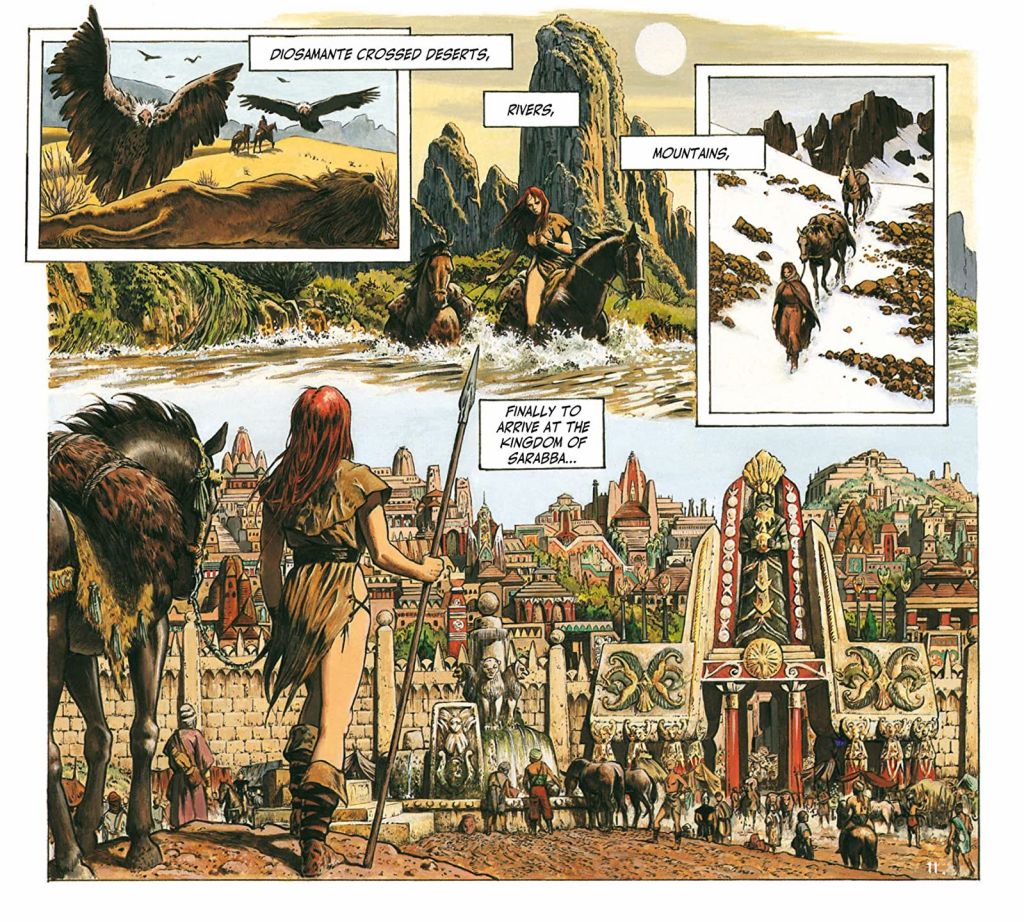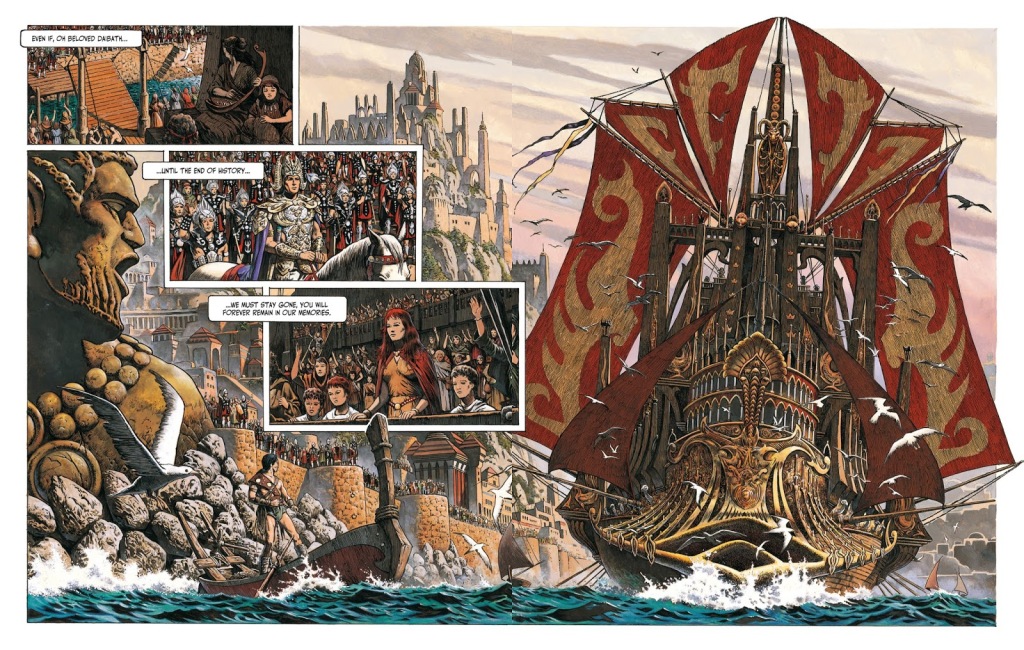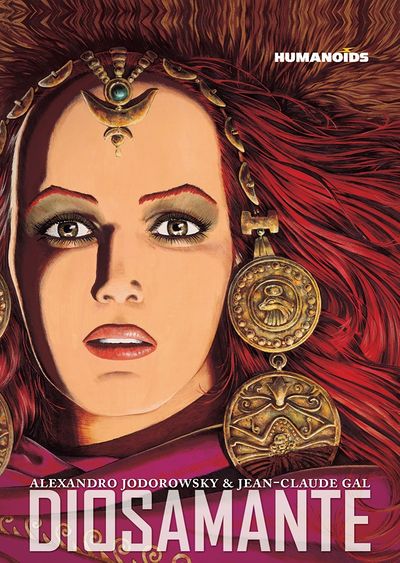Man, Jean-Claude Gal can draw, man. He must be among the greatest comic book artists of all time. Previously I read Armies (1977-88) which was his first work and the artistry that he put on display in that series was stunning. From the extremely detailed linework to the deep imagination of fantasy cities and landscapes, to the clever compositions of panels that pull the eye into the page… Gal did everything right. Gal also worked very slow, drawing perhaps 20 pages per year, which means that his total output in number of pages is small and the writer of Armies, Dionnet, was ready to move on to different projects when that was done. Dionnet suggested to Gal to ask Alejandro Jodorowsky to write a story for him.
Oh, boy.
I can never understand how comic artists can slave away, hour upon hour, week after week, to produce amazing art for stories that are so crappy. Now, Jodorowsky has a certain style as a writer that is getting dated very quickly. From the wacky New Age stuff of The Incal to the insane machismo of The Metabarons, his stories are always emotionally intense, full of crazy, split-second decisions, insane emotional outbursts and crazy male chauvinism. The best thing about his stories is that they have a mythological, fairytale-like logic. They play with archetypes in exaggerated versions of reality. That element is present in Diosamante as well, but gets overshadowed by nonsense and constant violence, sexual and otherwise.

But the art, man. The art. Each page is a masterwork. Jodorowsky pushed Gal to start working with color, because all of his work had been in black and white so far. The Armies series was coloured in after the fact and in a way that is visible. The panels don’t pop as well as the colours make them somehow flatter and drown out the lines. But for Diosamante, the linework was drawn with colours in mind from the beginning and it makes a difference.
Diosamante is a story about a powerful, cruel, arrogant queen who is so beautiful that every male in her kingdom fights to the death to become her lover. Then she meets a king from a neighbouring kingdom, immediately falls in love, feels shame and goes on a self-imposed exile to become enlightened, so that one day she can be good enough for the king. Her journey of exile makes no sense whatsoever. She blinds herself, learns the one thousand and one secrets of nature, seeks the Master Warriors, learns to meditate for weeks to reach a higher level of consciousness and so on. It’s full of nonsensical raving about mystical transformations, while Diosamante embarks on the most trite “tasks” on her quest. Meanwhile, not a single man she encounters can control his lusts upon seeing her. She constantly fights off men or is sold into slavery as every man loses his frickin mind. The story ends with Diosamante becoming the slave of some gorilla ape man who rapes her every day, eventually giving birth to two ape children. Then the ape man transforms into the king she was in love with from the start and they live happily ever after.
So, there you have it. Ten points for the artwork, zero points for Jodorowsky’s nonsensical raving. Unfortunately, Jean-Claude Gal passed away at a young age, leaving the saga of Diosamante unfinished. The Humanoids edition ends with a series of sketches that he produced for the sequel that never came: Diosamante’s Children. It also ends with a synopsis of what Jodorowsky’s story would have been for this sequel, and while it is sad that we will never see Gal’s artwork for it, we are also blessed to be spared that monstrosity of a tale.



It’s interesting, but often, because these drawings are functional, they don’t always come across as art. I’m not trying to be elitist here, not at all, just trying to voice something a struggle with myself: even though I can see this guy can draw, I’d rather look at drawings of Rembrandt, Picasso or Van Gogh. Maybe because this is too clean? Too much in service of? There’s not a lot of formal risk in these drawings. I don’t know. And obviously those three names are practically the top drawers ever, so.
LikeLiked by 2 people
Well, I think Gal was doing something that very few people are able to do. I’m not sure about the taking risks, but Gal was at the top in his particular game. For these big page covering images, the function was immersion, I think, and he utilizes composition and a high level of detail to dazzle the reader. It impressed me a lot.
LikeLiked by 2 people
Yea, Jodorowsky is a little nutty. Even when I was younger I could only handle him (his movies) in limited doses. I think he is one of those people deluded into thinking that good stories are some about ‘ideas’.
LikeLiked by 2 people
What annoys me the most about Jodorowsky is that he has very strange, unhealthy ideas about masculinity, his spiritual ideas are a scraped together bag of nonsense, and he is unable to see women as just humans. They are always queens or angels or witches or whores who only play roles his confused masculine-spiritual quests.
LikeLiked by 2 people
I was so excited for this review based on a quick scan of the art and then I read what you had to say about the story and it just went out of me like a deflated balloon. Thanks for the warning!
LikeLiked by 1 person
Oh no 😦 You could still try the artist’s other major work, Armies. The stories in Armies are written by another writer but the artist is the same.
LikeLiked by 1 person
Yeah, just read your review of that. Gonna put both on the longlist and see if i can pick them up at some point – just might pay a little less for this one…
LikeLiked by 1 person
It reminds me of Thorgal, tbh. The art, not the story (not a fan of Jodorowsky here ;)). I’ll take a look at the Armies, though, thanks for the rec!
LikeLike